South Korea Drug Delivery Devices Market Size
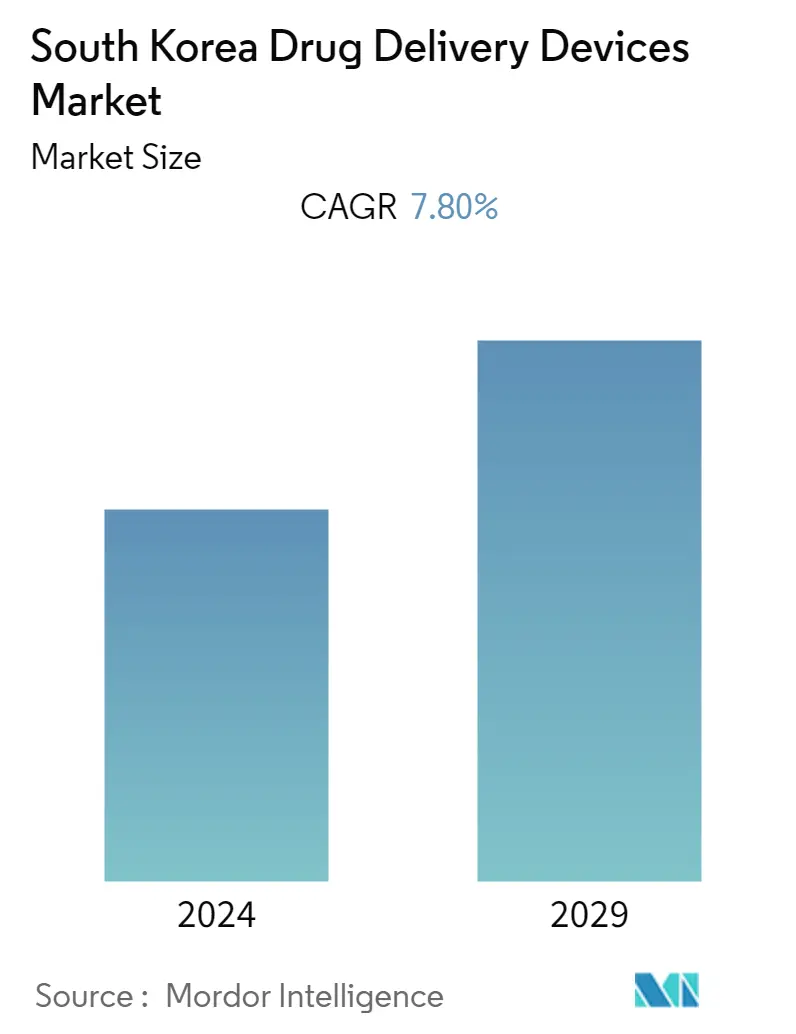
| Study Period | 2019 - 2029 |
| Base Year For Estimation | 2023 |
| Forecast Data Period | 2024 - 2029 |
| Historical Data Period | 2019 - 2022 |
| CAGR | 7.80 % |
Major Players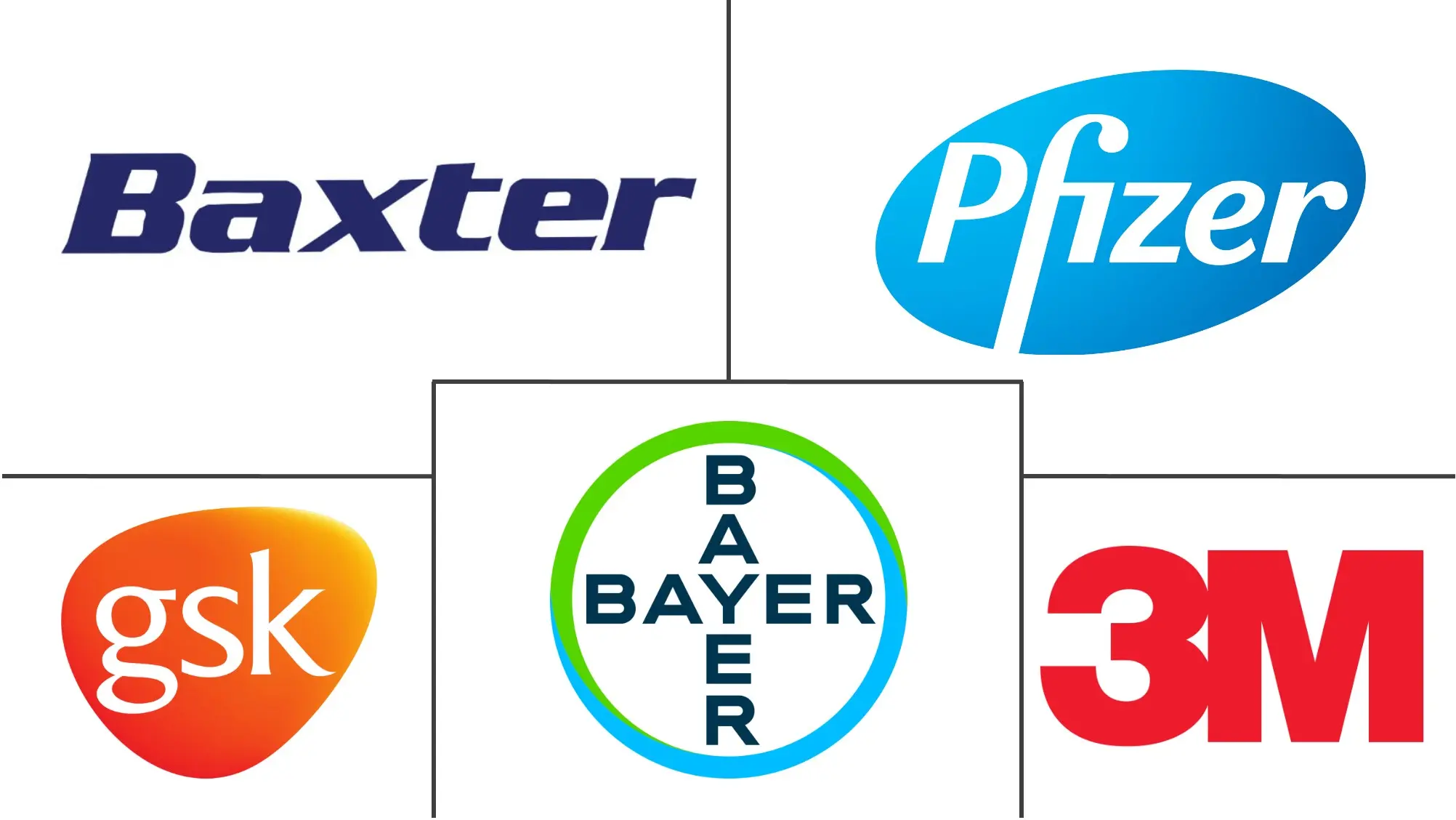
*Disclaimer: Major Players sorted in no particular order |
South Korea Drug Delivery Devices Market Analysis
The South Korean market for drug delivery devices is expected to exhibit a CAGR of 7.8% over the forecast period.
- The COVID-19 pandemic led to an increased focus by pharmaceutical companies and governments on providing effective medical therapy to COVID-19 patients, and drug delivery devices are expected to play a crucial role in this regard. Many companies were investing heavily in developing more efficient ways of delivering COVID-19 therapeutics to patients, which had a significant impact on the drug delivery market.
- For instance, in August 2020, Mankind Pharma and Daewoong Pharmaceutical of South Korea collaborated to conduct clinical studies on the anti-parasitic medication niclosamide for Covid-19. Therefore, COVID-19 is expected to have a significant impact on the growth of the drug delivery market over the forecast period. Currently, the use of drug delivery devices for COVID-19 treatment has returned to pre-pandemic levels in South Korea, but the pandemic initially had a significant impact on the market. Nevertheless, the market is expected to experience steady growth over the forecast period.
- Drug delivery devices are specialized tools for delivering drugs or therapeutic agents via a specific route of administration. In South Korea, the demand for these devices has primarily increased due to the rising prevalence of chronic diseases, such as cardiovascular diseases and cancer. For example, according to an article titled "Prediction of Cancer Incidence and Mortality in Korea, 2022," published in PubMed Central, 274,488 new cancer cases are anticipated to occur in Korea in 2022, with thyroid cancer predicted to be the most common type of cancer, followed by lung, colon and rectum, breast, and stomach cancer. Therefore, various types of drug delivery devices play an important role in targeted drug therapy for chronic diseases, thereby boosting the growth of the market.
- Market players are focusing on developing new products and engaging in acquisitions and collaborations, which are expected to fuel market growth during the forecast period. For instance, in November 2021, Innovation Zed, a developer of novel diabetes management technologies, announced the arrival of the InsulCheck DOSE technology (pen Injectable), which is expected to be launched in 2022. However, the increase in the risk of infections and stringent regulatory guidelines for the approval of drug-delivery devices have been limiting the growth of this market.
South Korea Drug Delivery Devices Market Trends
Injectable Segment is expected to Register High Growth in the Forecast Period in the South Korea Drug Delivery Devices Market
- The injectable segment is poised for rapid growth driven by several factors, including the rising burden of chronic diseases, the benefits and convenience of self-injectors, and the growth of the biologics market. In particular, the increasing prevalence of chronic diseases such as diabetes in South Korea is driving the overall use of syringes and self-injectable devices.
- According to the International Diabetes Federation 10th Edition 2021, 3,511.8 thousand people were suffering from diabetes in South Korea in 2021, and this number is projected to reach 3,860.9 thousand by 2045. This growing burden of disease is a major driver of market growth in South Korea.
- Market participants are actively developing new products and pursuing acquisitions and partnerships to capitalize on this growth opportunity. For example, in April 2022, GC Pharma began supplying HugPEG, an injection aid for Neulapeg (pegfilgrastim), to neutropenia patients who must administer the drug themselves. HugPEG enables users to attach and administer the pre-filled syringe combined with a needle guard, providing a more convenient and efficient way to administer injections compared to existing devices that give injections indirectly.
- Overall, the injectable segment is expected to experience significant growth over the forecast period due to the factors mentioned above.
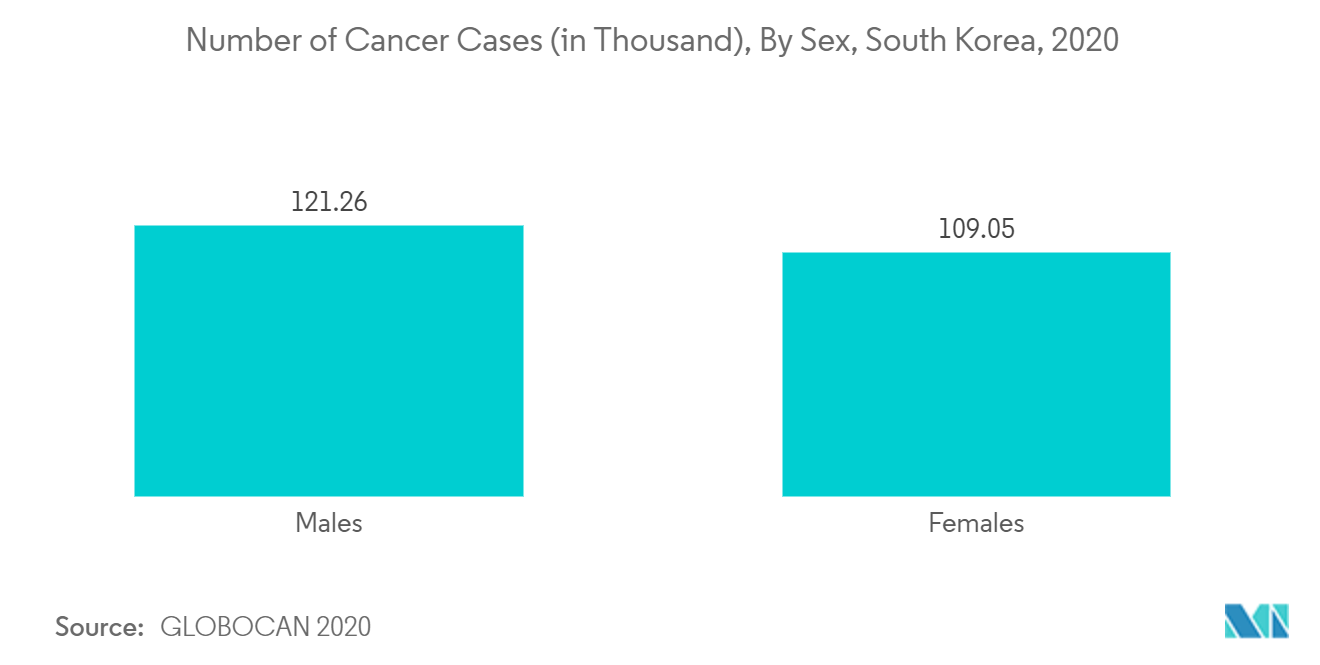
Topical Segment is expected to Grow Further During the Forecast Period in the South Korea Drug Delivery Devices Market
- Topical drug delivery devices are designed to deliver medication through the skin of the patient. Various research studies conducted by South Korean researchers have demonstrated the high effectiveness and widespread use of topical drug delivery devices, which are expected to create more demand and growth opportunities for these devices in South Korea.
- For instance, a study published in July 2021 by the researchers of Pusan National University in Biomaterials Research emphasized the advantages of transdermal drug delivery systems such as hyaluronic acid-based dissolving microneedle patches. These patches offer a low rejection rate, ease of administration, persistence, and convenience for patients.
- The study also noted that the transdermal drug delivery system is used for pharmaceuticals as well as for cosmetics, and it avoids the local build-up of the medicine concentration and nonspecific delivery to non-targeted tissue. Topical, transdermal patches have applications in the management of diabetes, dermatitis, metabolic dysfunctions, and other conditions.
- In October 2022, a study published in the Archives of Dermatological Research by researchers of Dongshin University, South Korea, highlighted the high efficacy of transdermal drug delivery using biodegradable hyaluronic acid MN patches (BHMN patches) for delivering drugs through the dry and sensitive skin of atopic dermatitis (AD) patients. The study demonstrated that BHMN patches can be an effective way to manage AD.
- Furthermore, a study published in the Journal of Biomaterials Research by the researchers of Konyang University College of Medicine, South Korea, underscored the high potential and advantages of using Verapamil patches. These are carboxymethyl pullulan-based supramolecular hydrogel patches with cross-linking citric acid and glycerol linkages (CLCMP) for managing a wide variety of chronic and metabolic diseases.
- The study found that the Verapamil-CLCMP patch was able to alleviate obesity-induced insulin resistance, and the CLCMP-based hydrogel patch offered more flexibility, ductile structure, improved drug loading capacity, and barrier performance, along with enhanced drug delivery and bioavailability, with crosslinking-of-citric-acid, glycerol, and CMP.
- Therefore, due to the wide applications and high efficacy of topical drug delivery devices, the topical segment is expected to witness significant growth over the forecast period.
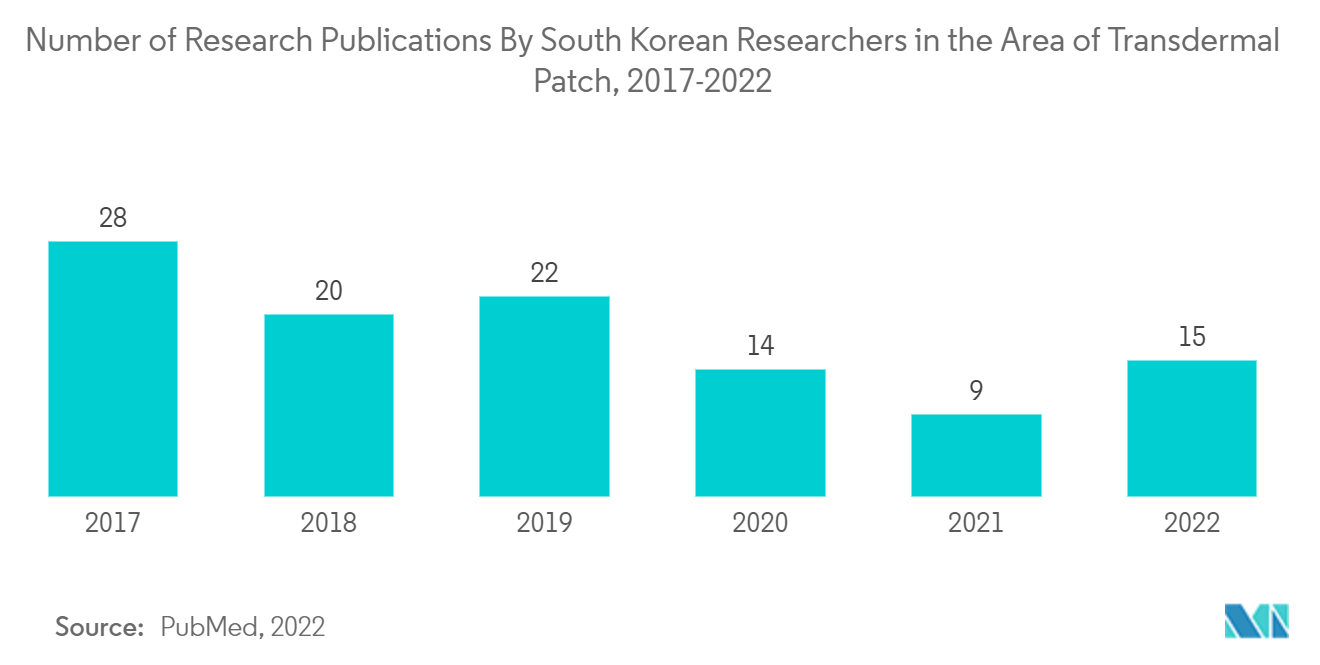
South Korea Drug Delivery Devices Industry Overview
The market studied is moderately competitive and comprises international as well as local players. South Korea is a highly developed country with a well-structured healthcare system in the country. As a result, many global players in the drug delivery devices market are present in the country. The competitive landscape includes an analysis of some international and local companies that hold market shares and are well known, including 3M, Baxter International, Bayer AG, F. Hoffmann-La Roche AG, GlaxoSmithKline PLC, Johnson & Johnson, Merck & Co., Novartis AG, Pfizer Inc, and QUADMEDICINE.
South Korea Drug Delivery Devices Market Leaders
-
Bayer
-
Baxter International
-
GlaxoSmithKline
-
3M Company
-
Pfizer Inc.
*Disclaimer: Major Players sorted in no particular order
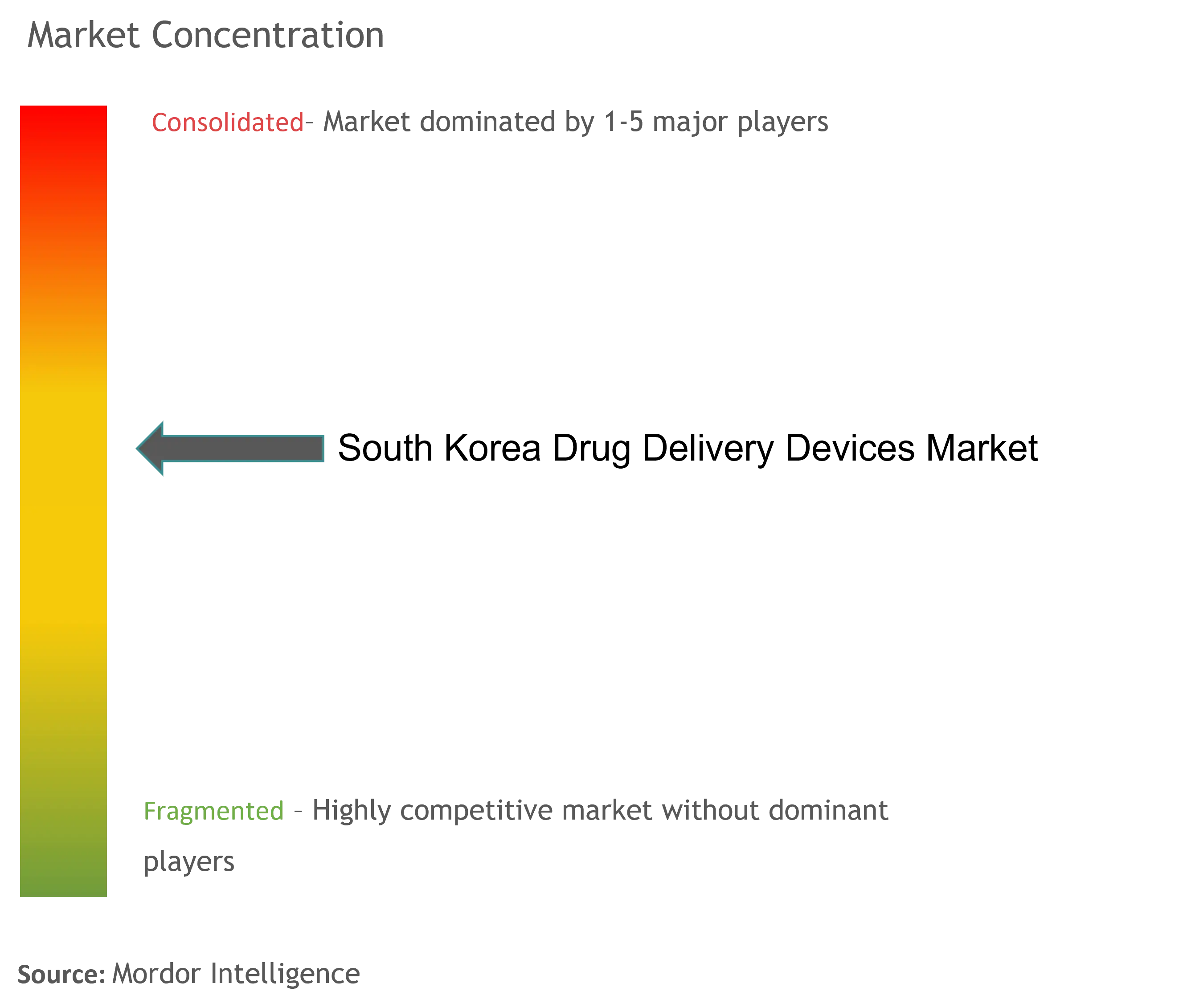
South Korea Drug Delivery Devices Market News
- March 2022: Futura Medical, a company developing transdermal DermaSys drug delivery technology, entered into a licensing agreement with Menarini Korea, a subsidiary of Menarini Group, for the exclusive rights to commercialize the company's gel-based Erectile Dysfunction (ED) treatment MED3000 in South Korea.
- November 2022: Medicox Co., Ltd. signed an exclusive distribution contract with an oral drug delivery platform developer, ORAMED Pharmaceuticals, for distribution rights for ORAMED's oral insulin in South Korea.
South Korea Drug Delivery Devices Market Report - Table of Contents
1. INTRODUCTION
- 1.1 Study Assumptions and Market Definition
- 1.2 Scope of the Study
2. RESEARCH METHODOLOGY
3. EXECUTIVE SUMMARY
4. MARKET DYNAMICS
- 4.1 Market Overview
-
4.2 Market Drivers
- 4.2.1 Increased Prevalence of Chronic Diseases
- 4.2.2 Requirement of Controlled Drug Release
-
4.3 Market Restraints
- 4.3.1 Risk of Infection During the Usage and Stringent Regulatory Guidelines
-
4.4 Porter's Five Forces Analysis
- 4.4.1 Threat of New Entrants
- 4.4.2 Bargaining Power of Buyers/Consumers
- 4.4.3 Bargaining Power of Suppliers
- 4.4.4 Threat of Substitute Products
- 4.4.5 Intensity of Competitive Rivalry
5. MARKET SEGMENTATION (Market Size By Value - USD million)
-
5.1 By Mode of Administration
- 5.1.1 Injectable
- 5.1.2 Topical
- 5.1.3 Ocular
- 5.1.4 Other Modes of Administration
-
5.2 By End-User
- 5.2.1 Hospitals
- 5.2.2 Ambulatory Surgical Centers
- 5.2.3 Other End-Users
6. COMPETITIVE LANDSCAPE
-
6.1 Company Profiles
- 6.1.1 3M
- 6.1.2 Baxter International
- 6.1.3 Bayer AG
- 6.1.4 F. Hoffmann-La Roche AG
- 6.1.5 GlaxoSmithKline PLC
- 6.1.6 Johnson & Johnson
- 6.1.7 Merck & Co.
- 6.1.8 Novartis AG
- 6.1.9 Pfizer Inc
- 6.1.10 QUADMEDICINE
- *List Not Exhaustive
7. MARKET OPPORTUNITIES AND FUTURE TRENDS
** Subject To AvailablitySouth Korea Drug Delivery Devices Industry Segmentation
As per the scope of the report, drug delivery devices are specialized tools used for the delivery of a drug or therapeutic agent through a specific route of administration. The devices are used one or more than one times for medical treatments. These devices are also used for safe and effective drug delivery.
The South Korean drug delivery devices market is segmented by mode of administration (injectable, topical, ocular, and others) and end-user (hospitals, ambulatory surgical centers, and other end-users).
The report offers the value (in USD million) for the above segments.
| By Mode of Administration | Injectable |
| Topical | |
| Ocular | |
| Other Modes of Administration | |
| By End-User | Hospitals |
| Ambulatory Surgical Centers | |
| Other End-Users |
South Korea Drug Delivery Devices Market Research FAQs
What is the current South Korea Drug Delivery Devices Market size?
The South Korea Drug Delivery Devices Market is projected to register a CAGR of 7.80% during the forecast period (2024-2029)
Who are the key players in South Korea Drug Delivery Devices Market?
Bayer, Baxter International, GlaxoSmithKline, 3M Company and Pfizer Inc. are the major companies operating in the South Korea Drug Delivery Devices Market.
What years does this South Korea Drug Delivery Devices Market cover?
The report covers the South Korea Drug Delivery Devices Market historical market size for years: 2019, 2020, 2021, 2022 and 2023. The report also forecasts the South Korea Drug Delivery Devices Market size for years: 2024, 2025, 2026, 2027, 2028 and 2029.
South Korea Drug Delivery Devices Industry Report
Statistics for the 2024 South Korea Drug Delivery Devices market share, size and revenue growth rate, created by Mordor Intelligence™ Industry Reports. South Korea Drug Delivery Devices analysis includes a market forecast outlook to for 2024 to 2029 and historical overview. Get a sample of this industry analysis as a free report PDF download.



